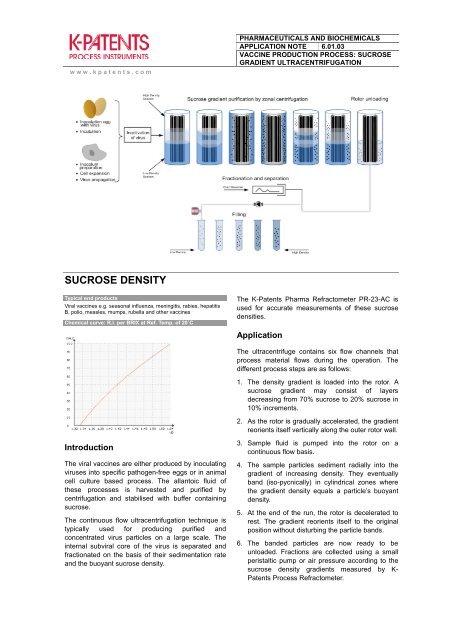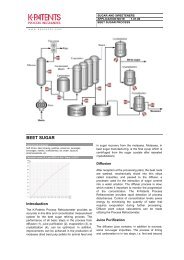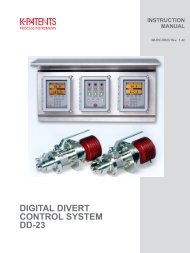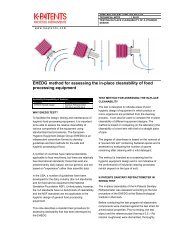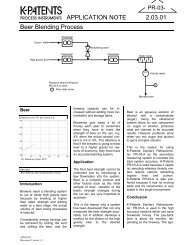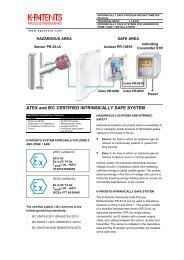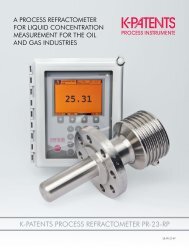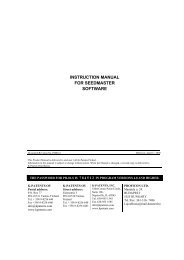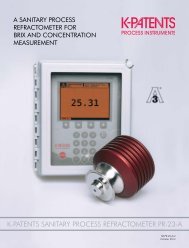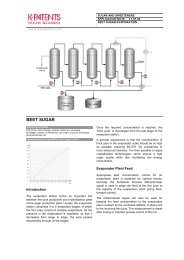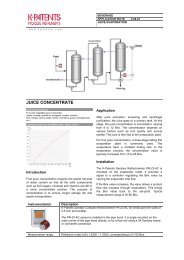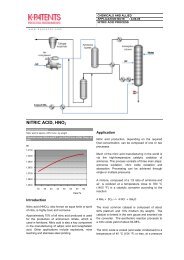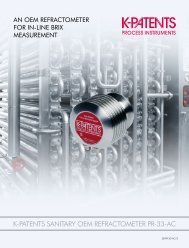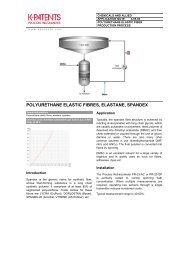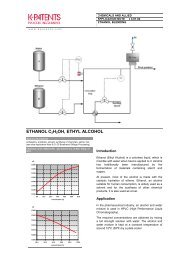SUCROSE DENSITY - K-Patents
SUCROSE DENSITY - K-Patents
SUCROSE DENSITY - K-Patents
Create successful ePaper yourself
Turn your PDF publications into a flip-book with our unique Google optimized e-Paper software.
www.kpatents.com<br />
PHARMACEUTICALS AND BIOCHEMICALS<br />
APPLICATION NOTE 6.01.03<br />
VACCINE PRODUCTION PROCESS: <strong>SUCROSE</strong><br />
GRADIENT ULTRACENTRIFUGATION<br />
<strong>SUCROSE</strong> <strong>DENSITY</strong><br />
Typical end products<br />
Viral vaccines e.g. seasonal influenza, meningitis, rabies, hepatitis<br />
B, polio, measles, mumps, rubella and other vaccines<br />
Chemical curve: R.I. per BRIX at Ref. Temp. of 20˚C<br />
The K-<strong>Patents</strong> Pharma Refractometer PR-23-AC is<br />
used for accurate measurements of these sucrose<br />
densities.<br />
Application<br />
The ultracentrifuge contains six flow channels that<br />
process material flows during the operation. The<br />
different process steps are as follows:<br />
1. The density gradient is loaded into the rotor. A<br />
sucrose gradient may consist of layers<br />
decreasing from 70% sucrose to 20% sucrose in<br />
10% increments.<br />
2. As the rotor is gradually accelerated, the gradient<br />
reorients itself vertically along the outer rotor wall.<br />
Introduction<br />
The viral vaccines are either produced by inoculating<br />
viruses into specific pathogen-free eggs or in animal<br />
cell culture based process. The allantoic fluid of<br />
these processes is harvested and purified by<br />
centrifugation and stabilised with buffer containing<br />
sucrose.<br />
The continuous flow ultracentrifugation technique is<br />
typically used for producing purified and<br />
concentrated virus particles on a large scale. The<br />
internal subviral core of the virus is separated and<br />
fractionated on the basis of their sedimentation rate<br />
and the buoyant sucrose density.<br />
3. Sample fluid is pumped into the rotor on a<br />
continuous flow basis.<br />
4. The sample particles sediment radially into the<br />
gradient of increasing density. They eventually<br />
band (iso-pycnically) in cylindrical zones where<br />
the gradient density equals a particle’s buoyant<br />
density.<br />
5. At the end of the run, the rotor is decelerated to<br />
rest. The gradient reorients itself to the original<br />
position without disturbing the particle bands.<br />
6. The banded particles are now ready to be<br />
unloaded. Fractions are collected using a small<br />
peristaltic pump or air pressure according to the<br />
sucrose density gradients measured by K-<br />
<strong>Patents</strong> Process Refractometer.
www.kpatents.com<br />
PHARMACEUTICALS AND BIOCHEMICALS<br />
APPLICATION NOTE 6.01.03<br />
VACCINE PRODUCTION PROCESS: <strong>SUCROSE</strong><br />
GRADIENT ULTRACENTRIFUGATION<br />
Installation<br />
The K-<strong>Patents</strong> Pharma Refractometer PR-23-AC can<br />
be installed in the vaccines fractionation unit for inline<br />
process control. The output of the transmitter is a<br />
4 to 20mA DC output signal proportional to sucrose<br />
solution density, concentration, Brix or other scale<br />
that has been selected for the instrument.<br />
The measurement signal is used for reliable and<br />
timely determination of the product peak in the<br />
density gradient (0 to 60% w/w sucrose), the<br />
subsequent collection of the virus rich fraction<br />
(Figure) and in diverting the virus rich fraction in the<br />
correct container.<br />
Another key area of the PR-23-AC application is in<br />
the research and development phase when the<br />
researchers need to develop a process<br />
understanding and to characterize the concentration<br />
(or density) of sucrose in each fraction. This<br />
information is valuable when formulating banding<br />
patterns and optimizing the target fraction. Once the<br />
operating procedure has been developed, the<br />
refractometer is required at the full scale production<br />
for determining the moment when to begin and to<br />
stop collecting the target fraction.<br />
The typical system comprises of a Pharma<br />
Refractometer PR-23-AC unit and a Pharma Mini<br />
Flow Cell PMFC-HSS that allows the sensor<br />
connection to the zone ultracentrifuge rotor<br />
unloading and fractionation phase. The standard<br />
Ethernet communication solution allows for<br />
simultaneous data logging and continuous<br />
monitoring of the measurement values and<br />
diagnostic data from an Indicating transmitter DTR to<br />
a computer via an Ethernet connection.<br />
The optional Field Communication software program<br />
CC-11 provides further communication features such<br />
as drawing and monitoring of real-time trend chart on<br />
the computer screen, saving the measurement data<br />
in PDF format and saving and storing the batch data<br />
over a selected period of time.<br />
Instrumentation<br />
Description<br />
K-<strong>Patents</strong> Pharma Refractometer PR-23-AC with Pharma Miniflow cell PMFC-<br />
HSS for installations with small sample volumes and 5 mm inlet and outlet clamp<br />
connections. Miniflow cell is installed to the sensor through a 3A Sanitary clamp.<br />
Measurement range:<br />
Refractive Index (nD) 1.3200 – 1.5300, corresponding to 0-100 Brix.


